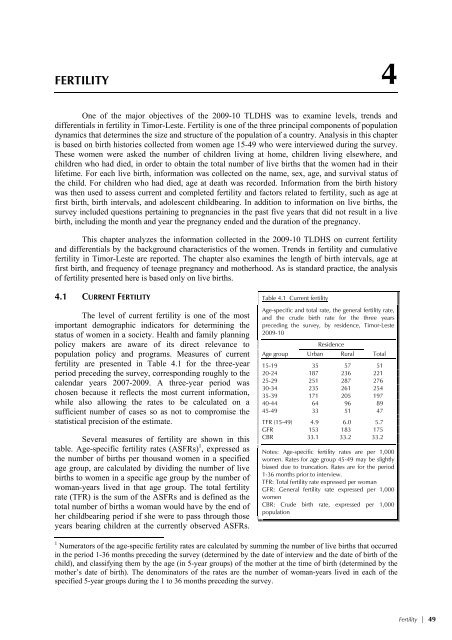Demographic and Health Survey 2009-10 - Timor-Leste Ministry of ...
Demographic and Health Survey 2009-10 - Timor-Leste Ministry of ...
Demographic and Health Survey 2009-10 - Timor-Leste Ministry of ...
You also want an ePaper? Increase the reach of your titles
YUMPU automatically turns print PDFs into web optimized ePapers that Google loves.
FERTILITY 4<br />
One <strong>of</strong> the major objectives <strong>of</strong> the <strong>2009</strong>-<strong>10</strong> TLDHS was to examine levels, trends <strong>and</strong><br />
differentials in fertility in <strong>Timor</strong>-<strong>Leste</strong>. Fertility is one <strong>of</strong> the three principal components <strong>of</strong> population<br />
dynamics that determines the size <strong>and</strong> structure <strong>of</strong> the population <strong>of</strong> a country. Analysis in this chapter<br />
is based on birth histories collected from women age 15-49 who were interviewed during the survey.<br />
These women were asked the number <strong>of</strong> children living at home, children living elsewhere, <strong>and</strong><br />
children who had died, in order to obtain the total number <strong>of</strong> live births that the women had in their<br />
lifetime. For each live birth, information was collected on the name, sex, age, <strong>and</strong> survival status <strong>of</strong><br />
the child. For children who had died, age at death was recorded. Information from the birth history<br />
was then used to assess current <strong>and</strong> completed fertility <strong>and</strong> factors related to fertility, such as age at<br />
first birth, birth intervals, <strong>and</strong> adolescent childbearing. In addition to information on live births, the<br />
survey included questions pertaining to pregnancies in the past five years that did not result in a live<br />
birth, including the month <strong>and</strong> year the pregnancy ended <strong>and</strong> the duration <strong>of</strong> the pregnancy.<br />
This chapter analyzes the information collected in the <strong>2009</strong>-<strong>10</strong> TLDHS on current fertility<br />
<strong>and</strong> differentials by the background characteristics <strong>of</strong> the women. Trends in fertility <strong>and</strong> cumulative<br />
fertility in <strong>Timor</strong>-<strong>Leste</strong> are reported. The chapter also examines the length <strong>of</strong> birth intervals, age at<br />
first birth, <strong>and</strong> frequency <strong>of</strong> teenage pregnancy <strong>and</strong> motherhood. As is st<strong>and</strong>ard practice, the analysis<br />
<strong>of</strong> fertility presented here is based only on live births.<br />
4.1 CURRENT FERTILITY<br />
The level <strong>of</strong> current fertility is one <strong>of</strong> the most<br />
important demographic indicators for determining the<br />
status <strong>of</strong> women in a society. <strong>Health</strong> <strong>and</strong> family planning<br />
policy makers are aware <strong>of</strong> its direct relevance to<br />
population policy <strong>and</strong> programs. Measures <strong>of</strong> current<br />
fertility are presented in Table 4.1 for the three-year<br />
period preceding the survey, corresponding roughly to the<br />
calendar years 2007-<strong>2009</strong>. A three-year period was<br />
chosen because it reflects the most current information,<br />
while also allowing the rates to be calculated on a<br />
sufficient number <strong>of</strong> cases so as not to compromise the<br />
statistical precision <strong>of</strong> the estimate.<br />
Several measures <strong>of</strong> fertility are shown in this<br />
table. Age-specific fertility rates (ASFRs) 1 , expressed as<br />
the number <strong>of</strong> births per thous<strong>and</strong> women in a specified<br />
age group, are calculated by dividing the number <strong>of</strong> live<br />
births to women in a specific age group by the number <strong>of</strong><br />
woman-years lived in that age group. The total fertility<br />
rate (TFR) is the sum <strong>of</strong> the ASFRs <strong>and</strong> is defined as the<br />
total number <strong>of</strong> births a woman would have by the end <strong>of</strong><br />
her childbearing period if she were to pass through those<br />
years bearing children at the currently observed ASFRs.<br />
Table 4.1 Current fertility<br />
Age-specific <strong>and</strong> total rate, the general fertility rate,<br />
<strong>and</strong> the crude birth rate for the three years<br />
preceding the survey, by residence, <strong>Timor</strong>-<strong>Leste</strong><br />
<strong>2009</strong>-<strong>10</strong><br />
Age group<br />
Residence<br />
Urban Rural<br />
1 Numerators <strong>of</strong> the age-specific fertility rates are calculated by summing the number <strong>of</strong> live births that occurred<br />
in the period 1-36 months preceding the survey (determined by the date <strong>of</strong> interview <strong>and</strong> the date <strong>of</strong> birth <strong>of</strong> the<br />
child), <strong>and</strong> classifying them by the age (in 5-year groups) <strong>of</strong> the mother at the time <strong>of</strong> birth (determined by the<br />
mother’s date <strong>of</strong> birth). The denominators <strong>of</strong> the rates are the number <strong>of</strong> woman-years lived in each <strong>of</strong> the<br />
specified 5-year groups during the 1 to 36 months preceding the survey.<br />
Total<br />
15-19 35 57 51<br />
20-24 187 236 221<br />
25-29 251 287 276<br />
30-34 235 261 254<br />
35-39 171 205 197<br />
40-44 64 96 89<br />
45-49 33 51 47<br />
TFR (15-49) 4.9 6.0 5.7<br />
GFR 153 183 175<br />
CBR 33.1 33.2 33.2<br />
Notes: Age-specific fertility rates are per 1,000<br />
women. Rates for age group 45-49 may be slightly<br />
biased due to truncation. Rates are for the period<br />
1-36 months prior to interview.<br />
TFR: Total fertility rate expressed per woman<br />
GFR: General fertility rate expressed per 1,000<br />
women<br />
CBR: Crude birth rate, expressed per 1,000<br />
population<br />
Fertility | 49
















